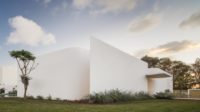In Milan, Nouvel Fashions an 'Extreme' Exhibition

Nouvel Fashions
“Extreme Beauty in Vogue” is housed inside the Palazzo della Ragione, in Milan. Vogue curated the exhibition and Jean Nouvel designed it.
Photo courtesy Dolce & Gabbana

Nouvel Fashions
Outside the palazzo, a 10,000-square-foot reception structure was erected to welcome celebrities and paparazzi on opening night.
Photo courtesy Dolce & Gabbana

Nouvel Fashions
Inside, a two-story interior scaffolding runs along the central axis of the palazzo.
Photo courtesy Dolce & Gabbana

Nouvel Fashions
The loggia is dotted with velvet-draped couches. Nouvel has likened his environment to a dream-like state, and he says that the exhibit’s flickering lights and velvet-clad niches are “meant to encourage a sense of exclusivity and meditation.”
Photo courtesy Dolce & Gabbana

Nouvel Fashions
On display are 89 works by photographers commissioned by Vogue over the past 75 years, including Irving Penn, Richard Avedon, and Steven Klein.
Photo courtesy Dolce & Gabbana

Nouvel Fashions
The exhibition examines various depictions of beauty.
Photo courtesy Dolce & Gabbana

Nouvel Fashions
A photograph by Steven Klein titled “Strength Training.”
Photo courtesy Dolce & Gabbana

Nouvel Fashions
The exhibition opened on March 4, during Fashion Week in Milan. It runs through May 10.
Photo courtesy FACTOID/Valère Terrier

Nouvel Fashions
Jean Nouvel says of his design: “The focus is to investigate, interpret, and celebrate the eternal nature of beauty and its ability to transcend and inspire.”
Photo courtesy FACTOID/Valère Terrier
The economy hasn’t come to a complete halt. In late January Dolce & Gabbana introduced its first cosmetics collection, which namesake Stefano Gabbana calls “essential, yet an indulgence.” To celebrate the launch, the Italian fashion house asked Vogue to curate “Extreme Beauty in Vogue,” a photographic survey of beauty in that magazine, and asked French architect Jean Nouvel to design the exhibition.
The two-month-long installation opened in Milan on March 4 to correspond with the ready-to-wear shows. “We wanted this to be accessible, yet feel personal,” Gabbana notes, “and we also wanted this exhibition as a sort of a gift for Milan, our city.”
“Extreme Beauty in Vogue” is housed inside the Palazzo della Ragione, a building that itself represents the convergence of commerce and record-keeping: The palazzo was constructed near the Duomo in 1228 as a meeting point for merchants to do business, and in 1771 Empress Maria Theresa expanded the original colonnaded structure to contain an archive of notarized documents.
For the exhibition, Nouvel added another, temporary layer to the palimpsest. Outside the palazzo, a 10,000-square-foot reception structure was erected for the sole purpose of welcoming celebrities and paparazzi on opening night. Those high-profile guests then walked through an existing loggia dotted with velvet-draped couches, proceeding to the palazzo itself.
Inside, a two-story interior scaffolding runs along the central axis of the palazzo. (Unlike the exterior interventions, the scaffolding will remain in operation through the close of the exhibition, on May 10.) A series of velvet-clad niches lines this framework, and inside each recess an easel props up one of 89 works by Irving Penn, Richard Avedon, Steven Klein, and other photographers commissioned by Vogue over the last 75 years. The phrase “Gloria Venustati,” or Glory to Beauty, is video-projected onto interior walls. “This is homage to the artistic masters of the past [that] correlates directly to the modern photographic works on display,” Nouvel says of selecting the phrase.
The French architect notes that the design transcends religion, politics, and economics. “The focus is to investigate, interpret, and celebrate the eternal nature of beauty and its ability to transcend and inspire,” he says.
Yet the exhibition design does suggest a certain wrestling with—and escape from—the current recession. Nouvel has likened his environment to a dream-like state, and he says that the exhibit’s flickering lights and velvet-clad niches are “meant to encourage a sense of exclusivity and meditation.” Milan residents will be reminded of these qualities for however long the economic doldrums persist: Nouvel designed a gate for the palazzo entrance that Dolce & Gabbana has already donated to the municipality.




